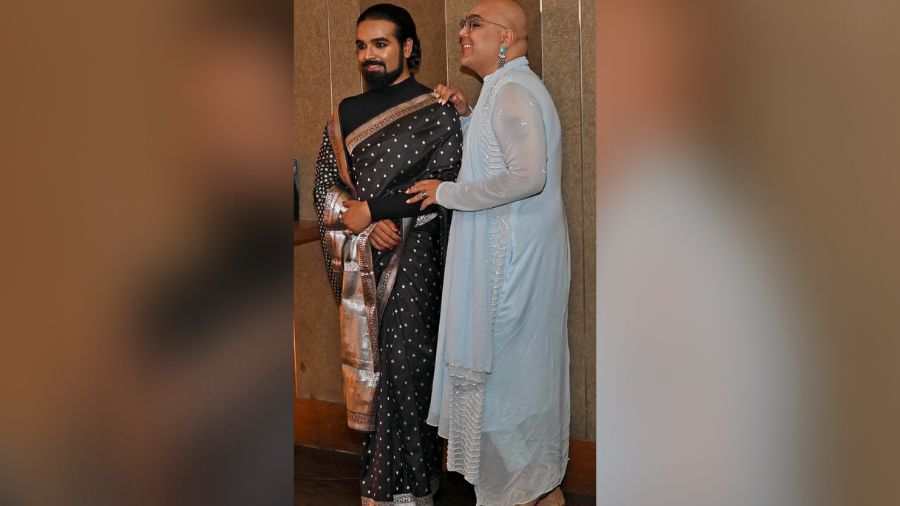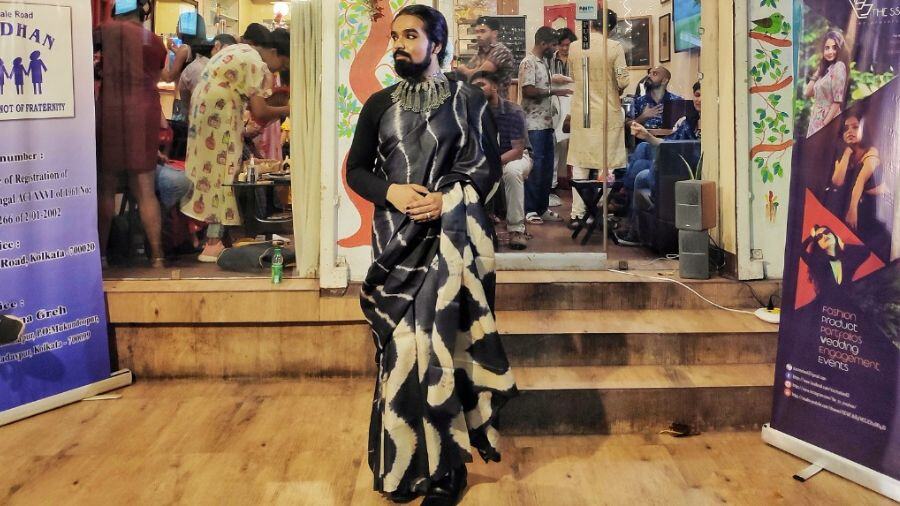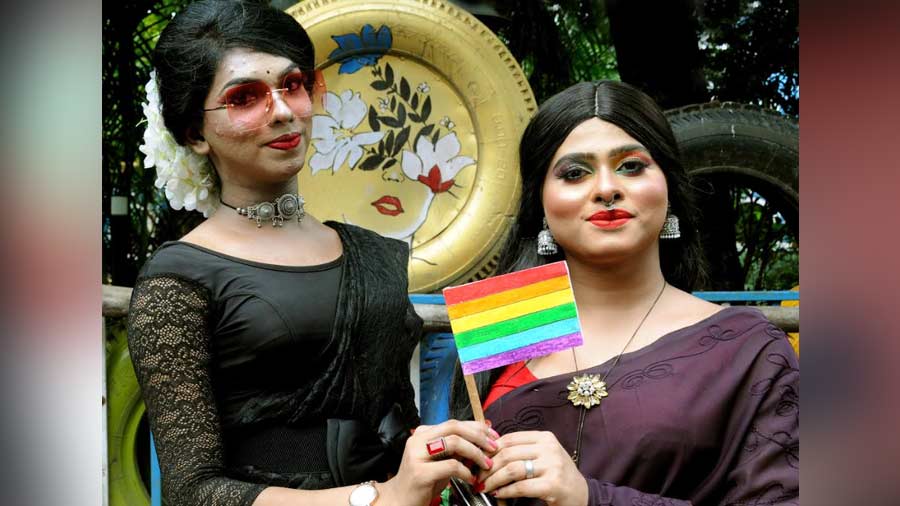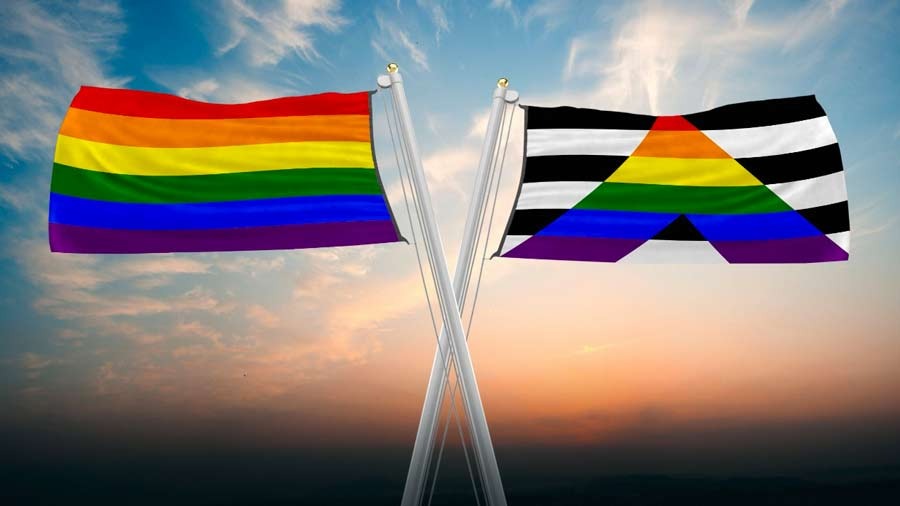Pushpak Sen is stirring a revolution — and dressing up for it. The fashion tastemaker, who’s more popularly known as The Bong Munda, made headlines when he walked the streets of Milan in a handloom sari earlier this year. His red bindi and immaculate draping took the fashion circuit by storm.
Sen recalls that he has been wearing a dhuti — unstitched Indian garment that’s roughly the same length as a sari, that also needs draping — for years. And that is, in fact, how the sari came into his life.
“If I am wearing a dhuti, the back portion — instead of tucking in my waist, I just put it on my shoulder and that changes the entire narrative. If I drape it in a certain way it’s acceptable and if I don’t drape it in a certain way it raises eyebrows — I think these are extremely boring concepts,” remarks Sen.
In a freewheeling chat with My Kolkata, Sen shares his perspectives on fluidity, his relationship with the sari and why Kolkata is the best city for a queer person. Read on…
My Kolkata: How did the sari come into your life?
Pushpak Sen: I have been wearing a sari as a dhuti forever, since my school days — long before Instagram and Facebook were a thing because I have always been an experimental person. I have always felt connected to my roots. I also thought sari and dhuti are almost of similar length with a difference of half a metre or a metre, which is not much of a problem.
I eventually started wearing sari as dhuti because they would look stylish and eye-catching. So that is how my tryst with saris began. Later when I got the opportunity to go to Italy, I also made a conscious decision that I would take some of my mom’s saris and would wear them as dhutis in class or on special occasions, because, why not? I was there to represent my country, my roots and my culture. I was there to take my culture forward.
For me, the sari is more than a piece of pretty fabric. It is a story in itself. Every sari has its own character, its own history. And to me, it is the finest artistry that our country has to offer. I am not only talking about Bengali saris, I am talking about saris in general. My idea was, that even if one person sees me in a sari in the world’s fashion capital, notices and remembers me — that would be enough.
Your ‘bindi’ also made quite a statement. What is the significance of it?
I think, to be very honest, because I have so much facial hair and it’s jet black, the red bindi offers a colour break and it also immediately elevates the entire look. I have also always been very inspired by the women in my family or around me and what better way to pay homage to them than to carry their signature with me?
For anyone asking about the red dot on my forehead, I would say it’s serving its purpose — I have your attention. When I am talking to you, your focus is going to be on the red dot. So, there, you have it!
“My sartorial sense has got nothing to do with my sexuality”
Your protest on the streets of Milan against the voting down of a bill protecting the LGBTQ+ community, in a sari, was a very powerful message. Did you expect this image to go viral?
Absolutely not, because whenever I do or post something, I have zero expectations. Basically, I have zero expectations out of everything and everyone, because I am very self-sustained.
The pictures (in Milan) were taken at the last moment. I went there for a day out with my friends, and while returning I was like, ‘oho today I am in Milan and I did not take pictures, come let’s quickly take photos!’ We clicked those 5-6 pictures in less than a minute, and that was it. I felt great and I felt amazing that I was wearing a sari in Milan, which is one of the fashion capitals of the world. Obviously, I did not expect anything to go viral because I know a lot of content creators on social media do a lot of crazy things to go viral. But, I don’t belong in that clan because I know that whoever has to appreciate me will anyway do it — whether viral or not.
I was there when the bill was voted down. Honestly, I think my clothes go beyond my sexuality or my gender. I think it’s irrelevant to the conversation about my orientation. I was always non-binary, if I may say so. I don’t believe in labels and I have always known that in my consciousness.
Fashion is supposed to be fun, revolutionary, and a voice. It is supposed to be more than just glamorous clothes. Fashion does not lie in your clothes. It lies in your confidence, the way you speak and the way you think. Honestly, all kinds of agendas aside, my sartorial sense has got nothing to do with my sexuality.
How has life changed for you, post that viral image?
I wasn’t really protesting. I was existing. Being myself. But of course! My life changed the moment I landed in Italy. I say to everyone that I have two phases in my entire timeline, which are pre-Italy and post-Italy. Obviously, my life has changed and all it took was six saris, a little bit of courage, and a lot of compassion.
“I think that Kolkata is one of the best cities for any queer person”
When you walk the streets of Kolkata in a sari, how do people react to gender-fluid dressing?
I get three kinds of reactions. One, they don’t have the time to look at me. Second, people are very intrigued and they stare. And third, people are very confused and they stare.
Even if they are very interested or amused, or they find me very beautiful, they’ll stare at me to an extent that I might feel uncomfortable. Otherwise, they are very confused — ‘is this a social experiment’, ‘is he doing a prank video, are there hidden cameras anywhere’, ‘what exactly is happening?’
I am very sure that I am not the first person or the first man to be wearing a sari, in India, especially. So, it’s rather easy for me to wear a sari in public and online. I’ll tell you why — because whether they like it or not, we don’t have the guts or the courage to walk to someone and tell someone to their face that you are looking rubbish. Or, you look amazing, congratulations and fantastic! So either way, if someone is looking at me I can mind my own business. When it comes to Instagram, you can come and say anything and everything behind a fake account. So it’s easier for me to wear a sari in public than online.
“We are more than just rainbow clothes and loud make-up”
How was your experience of styling Gourab Mullick for Cannes?
I value my friendships a lot. Many of my friends are creative. By creative I do not necessarily mean someone who is a dancer or is making a film. I have friends who are doing amazing things in the tech and medicine industries. I think that also needs a lot of creativity.
I have known Gourab-da since 2015 when we were both college students. I was in Asutosh College and Gourab-da was in St. Xavier's doing his undergrad. I used to participate in every kind of fest, be it theatre, or creative writing. I was a very active young adult and we came across each other on social media and we have been friends since then.
When he went to Cannes he DM-ed me and said, ‘hi I am going to Cannes and I need 10 looks that you have to put together for me.’ For the red carpet moment, I again reached out to a very close friend of mine — Agnik who put together the entire panjabi look within 10 days. Also, Parama-di whose dhuti Gourab-da was wearing.
Bengal in general has so much talent to offer to the world. If I am styling someone, no matter who you are — a celebrity, my friend or a client — I will make sure that something from your roots is on you when you are representing our country.
On a whole, it was a process, a moment of friends holding each other's hands and moving forward.
How do you see the general consciousness and understanding of homosexuality and the queer communities in India? Also, now that you are living overseas, what are the differences?
Obviously the differences would be the way the so-called first-world countries look at everything in life. It is very different from how we look at it. Because to us, a lot of things come into play, like your traditions, customs, base, values, roots, etc. More so for a country like India because every 200 kilometres the language changes, the accent changes. The traditions and customs change. That’s the beauty of my country — we are so different, yet stay together. And while some communities can be very open, some communities might be very conservative.
But abroad, everything is very homogeneous. It’s kind of boring that way. And people, in general, don’t have even a second to think about why a person is doing what they’re doing. So, I think that is the biggest difference. And the general idea of queerness or queer culture in India is very self-explanatory. We have come so far from 2018. The 2018 judgment decriminalising Article 377 happened because of the queer movement, the queer marches since 2015. It showed that we are more than just rainbow clothes and loud make-up. We are professionals, doctors and engineers — we are individuals more than anything.
“I never felt the need to come out.”
Would you like to share what your own coming-out journey was like?
I never felt the need to come out. About the whole coming out of the closet thing — which closet are we talking about? Coming out from where? We never built a closet in the first place, we have always been here. It’s not like suddenly in 2018 a bunch of queer people landed from heaven and started walking on Earth. We have been here since the beginning of time and it is the so-called straight, heteronormative society that built the closet and shoved us inside, and then put the onus on us to come out of it.
As if it is a custom, a tradition that if you are queer, you have to come out. No! The only person who has to come out is, I think, themselves and if that is done everything is done.
At the end of the day, if you are holding yourself with full dignity and if you believe in what you are doing, making the world a better place — I don’t think there is any need for anyone to come out. If someone doesn’t want to come out, that’s okay. I never did, consciously. And, it did not matter to my strength, to the people who really loved me. They look beyond my sexuality or whatever it is. They look at me as a person, they look at my energy, vibe and personality. And that’s about it.
“Every individual is more than their sexuality.”
‘Coming out’ is often dependent on the socio-economic situation of the person. A person with limited means and financial foothold might perhaps not have the scope to establish one's sexuality. Your take?
It’s absolutely fine if someone doesn’t. Okay, if someone feels the need to come out in whatever capacity possible to whoever it is, there is no time limit or no particular time to come out. You can come out when you are 12 years old, when you are 18 years old, you can come out when you are 78 years old, or you can never come out. It’s your choice!
Establishing one’s sexuality is very redundant. I mean, would you ever establish yourself as a non-vegetarian or a vegetarian? No. In the entire animal kingdom, our most basic instincts are hunger, sleep and sexual urges. How is it breaking news that someone likes someone?
Irrespective of their sexuality, everyone should be proud to exist and to be themselves. And that is exactly what pride means to me — to show that all of us are different, we have different colours and various shades, but we are all rainbows, deep down somewhere.

Pushpak Sen at the fundraising event ‘Rang Saga’ on May 28, 2022 Amit Datta
“We decide to exist in our full flamboyance, we choose to stand by our principles, and we choose to live in our maximum beauty.”
If you have to define 'pride,’ how would you describe it?
The ‘pride’ in Pride Month is the pride that lies in the fact that whatever others’ judgements are, whatever they may think of us, we choose to rise above all of that. And we choose to hold hands and rise together. We only rise when we raise others in the journey, and we are proud to be who we are — beyond all your stereotypes, frownings and sceptical glances. We decide to exist in our full flamboyance, we choose to stand by our principles, and we choose to live in our maximum beauty. And that is something to be proud of. The LGBTQIA community does it better than anyone.
What are your future plans, and do they involve Kolkata?
Of course! I tell people that you can take me out of Kolkata, out of India, but you can never take India and Kolkata out of me. See, Kolkata is my hometown but Bengal is my culture. And we need to understand that when we refer to Bangali, we should not be referring to only Kolkata Bangali. We should be referring to the Bangalis in Darjeeling, in the Sunderbans. And I am inspired by every nook and corner that this state and this country has to offer to me.
I don’t live in the future or the past. I live in the present. And especially after the pandemic, I don’t know if I’ll be alive or not in the next two months! All I believe in is having courage and being kind and compassionate. And that is enough.

Pushpak Sen as the chief guest of the event Colour Street on June 10, 2022 Soumyajit Dey
Your message for the LGBTQIA community in Kolkata?
I would say that we should keep in mind that we have been iconic since the beginning of the entire LGBTQIA pride parade in India. Because back in 1995, it was started by a few gentlemen here, right in my city. And, by only 15-16 people, I think it was definitely less than 50. And they would call it ‘friends march’ or something because of whatever reasons. So, we have shown the way.
What Bengal thinks today, the world thinks tomorrow. And I think that Kolkata is one of the best cities for any queer person to be in because the compassion, the love that my fellow Bangalis give me is so much more than (what I would have got in another) town. They might frown upon you today, but tomorrow they’ll understand, make an effort to understand. Today they are frowning on you, tomorrow they’ll be friends with you. That is why I love Bengal because as Bengalis we have this tendency to fetch more knowledge, understand things, and have discussions. And that is why I am so proud to be a Bangali.
Rapid Fire:
Your fav saris?
Always a sada-laal paar sari — the simple khorke-durey sari that women from all over Bengal wear. Be it, my tribal sister, from Purulia or be it Aparna Sen, or be it the matriarch of Sovabazar Rajbari. Be it my mom, my thamma, Goddess Durga. The sada-laal paar sari is iconic.
What does Kolkata mean to you?
It means beauty, existence and peace.
Three Kolkata locations that are perfect backdrops to a sari?
Sovabazar Gangar ghat, any vintage lane in south Kolkata, be it Gariahat, Muldiali or Harish Mukherjee Street. And of course the Howrah bridge and Prinsep Ghat.
Two Instagram accounts you love to follow?
I love to follow India Culture Hub and Brown History.
Fashion to you is?
Fashion is more than just a glamorous word or a magazine. Fashion to me is an emotion, it’s a tone of voice, it’s an extension of your personality.
Three wishes?
First, to have an excellent metabolism so I don’t gain any kind of weight and have unlimited amounts of mishti, because I have a huge sweet tooth.
The second would be to always be friends with the iconic people of my country.
Third would be the most cliched one — more wishes as and when the time comes.


